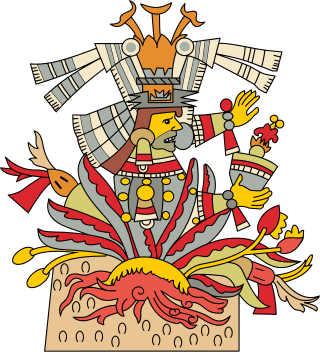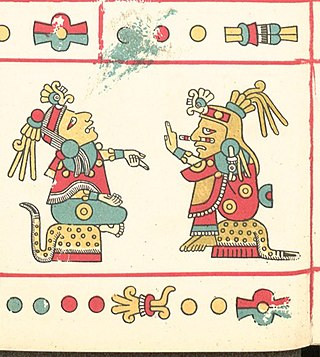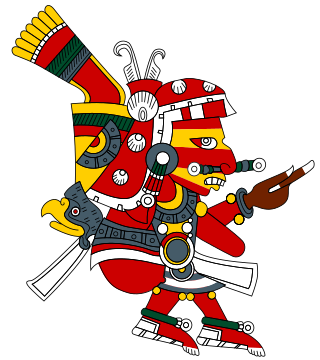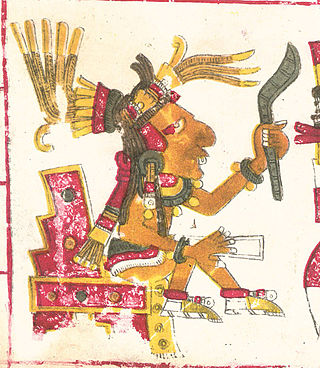
Aztec mythology is the body or collection of myths of the Aztec civilization of Central Mexico. The Aztecs were Nahuatl-speaking groups living in central Mexico and much of their mythology is similar to that of other Mesoamerican cultures. According to legend, the various groups who became the Aztecs arrived from the North into the Anahuac valley around Lake Texcoco. The location of this valley and lake of destination is clear – it is the heart of modern Mexico City – but little can be known with certainty about the origin of the Aztec. There are different accounts of their origin. In the myth, the ancestors of the Mexica/Aztec came from a place in the north called Aztlan, the last of seven nahuatlacas to make the journey southward, hence their name "Azteca." Other accounts cite their origin in Chicomoztoc, "the place of the seven caves", or at Tamoanchan.

Mayahuel is the female deity associated with the maguey plant among cultures of central Mexico in the Postclassic era of pre-Columbian Mesoamerican chronology, and in particular of the Aztec cultures. As the personification of the maguey plant, Mayahuel is also part of a complex of interrelated maternal and fertility goddesses in Aztec religion and is also connected with notions of fecundity and nourishment.

In Aztec mythology, Tonacatecuhtli was a creator and fertility god, worshipped for populating the earth and making it fruitful. Most Colonial-era manuscripts equate him with Ōmetēcuhtli. His consort was Tonacacihuatl.
Ixtlilton in Aztec mythology is a god of medicine and healing and therefore was often alluded to as the brother of Macuilxochitl, the god of well-being or good luck. Ixtlilton was a gentle god, who emanated from an obsidian mask which brought darkness and peaceful sleep to children in their beds at night.

Ōmeteōtl is a name used to refer to the pair of Aztec deities Ometecuhtli and Omecihuatl, also known as Tōnacātēcuhtli and Tonacacihuatl. Ōme translates as "two" or "dual" in Nahuatl and teōtl translates as "god". The existence of such a concept and its significance is a matter of dispute among scholars of Mesoamerican religion. Ometeotl was one as the first divinity, and Ometecuhtli and Omecihuatl when the being became two to be able to reproduce all creation.

In Aztec mythology, Xipe Totec or Xipetotec was a life-death-rebirth deity, god of agriculture, vegetation, the east, spring, goldsmiths, silversmiths, liberation, deadly warfare, the seasons, and the earth. The female equivalent of Xipe Totec was the goddess Xilonen-Chicomecoatl.

Agave americana, commonly known as the century plant, maguey, or American aloe, is a flowering plant species belonging to the family Asparagaceae. It is native to Mexico and the United States, specifically Texas. This plant is widely cultivated worldwide for its ornamental value and has become naturalized in various regions, including Southern California, the West Indies, South America, the Mediterranean Basin, Africa, the Canary Islands, India, China, Thailand, and Australia.

The Aztec Empire or the Triple Alliance was an alliance of three Nahua city-states: Mexico-Tenochtitlan, Tetzcoco, and Tlacopan. These three city-states ruled that area in and around the Valley of Mexico from 1428 until the combined forces of the Spanish conquistadores and their native allies who ruled under Hernán Cortés defeated them in 1521.
Macuiltochtli is one of the five deities from Aztec and other central Mexican pre-Columbian mythological traditions who, known collectively as the Ahuiateteo, symbolized excess, over-indulgence and the attendant punishments and consequences thereof.

The Aztec religion is a polytheistic and monistic pantheism in which the Nahua concept of teotl was construed as the supreme god Ometeotl, as well as a diverse pantheon of lesser gods and manifestations of nature. The popular religion tended to embrace the mythological and polytheistic aspects, and the Aztec Empire's state religion sponsored both the monism of the upper classes and the popular heterodoxies.

In Aztec mythology, Tepoztēcatl or Tēzcatzontēcatl was the god of pulque, of drunkenness and fertility. The deity was also known by his calendrical name, Ometochtli ("two-rabbit"). He is a consort of Mayahuel, who is a mask-avatar of Xōchiquetzal.

In Aztec mythology, Ometochtli is the collective or generic name of various individual deities and supernatural figures associated with pulque, an alcoholic beverage derived from the fermented sap of the maguey plant. By the Late Postclassic period of Mesoamerican chronology a collection of beliefs and religious practices had arisen in the context of the manufacture and ritualistic consumption of the beverage, known as the "pulque cult" with probable origins in a mountainous region of central Mexico. In Aztec society octli rituals formed a major component of Aztec religion and observance, and there were numerous local deities and classes of sacerdotes ("priests") associated with it.

Codex Ríos is an Italian translation and augmentation of a Spanish colonial-era manuscript, Codex Telleriano-Remensis, that is partially attributed to Pedro de los Ríos, a Dominican friar working in Oaxaca and Puebla between 1547 and 1562. The codex itself was likely written and drawn in Italy after 1566.

Aztec cuisine is the cuisine of the former Aztec Empire and the Nahua peoples of the Valley of Mexico prior to European contact in 1519.

Pulque, occasionally known as octli or agave wine, is an alcoholic beverage made from the fermented sap of the maguey (agave) plant. It is traditional in central Mexico, where it has been produced for millennia. It has the color of milk, a rather viscous consistency and a sour yeast-like taste.

Aztec medicine conerns the body of knowledge, belief and ritual surrounding human health and sickness, as observed among the Nahuatl-speaking people in the Aztec realm of central Mexico. The Aztecs knew of and used an extensive inventory consisting of hundreds of different medicinal herbs and plants. A variety of indigenous Nahua and Novohispanic written works survived from the conquest and later colonial periods that describe aspects of the Aztec system and practice of medicine and its remedies, incantations, practical administration, and cultural underpinnings. Elements of traditional medicinal practices and beliefs are still found among modern-day Nahua communities, often intermixed with European or other later influences.
In Aztec mythology the Lords of the Day are a set of thirteen gods that ruled over a particular day corresponding to one of the thirteen heavens. They were cyclical, so that the same god recurred every thirteen days. In the Aztec calendar, the lords of the day are
- Xiuhtecuhtli, god of fire and time.
- Tlaltecuhtli, goddess of the earth.
- Chalchiuhtlicue, goddess of water, lakes, rivers, seas, streams, horizontal waters, storms and baptism.
- Tonatiuh, god of the sun.
- Tlazolteotl, goddess of lust, carnality, sexual misdeeds.
- Mictlantecuhtli, god of the underworld.
- Centeotl, god of maize. Also recognized as Chicomecoatl, goddess of agriculture.
- Tlaloc, god of the thunder, rain and earthquakes.
- Quetzalcoatl, god of wisdom, life, knowledge, morning star, fertility, patron of the winds and the light, the lord of the West.
- Tezcatlipoca, god of providence, matter and the invisible, ruler of the night, Great Bear, impalpable, ubiquity and the twilight, the lord of the North.
- Mictecacihuatl, goddess of the underworld.
- Tlahuizcalpantecuhtli, god of dawn.
- Citlalicue, goddess of the female stars.














